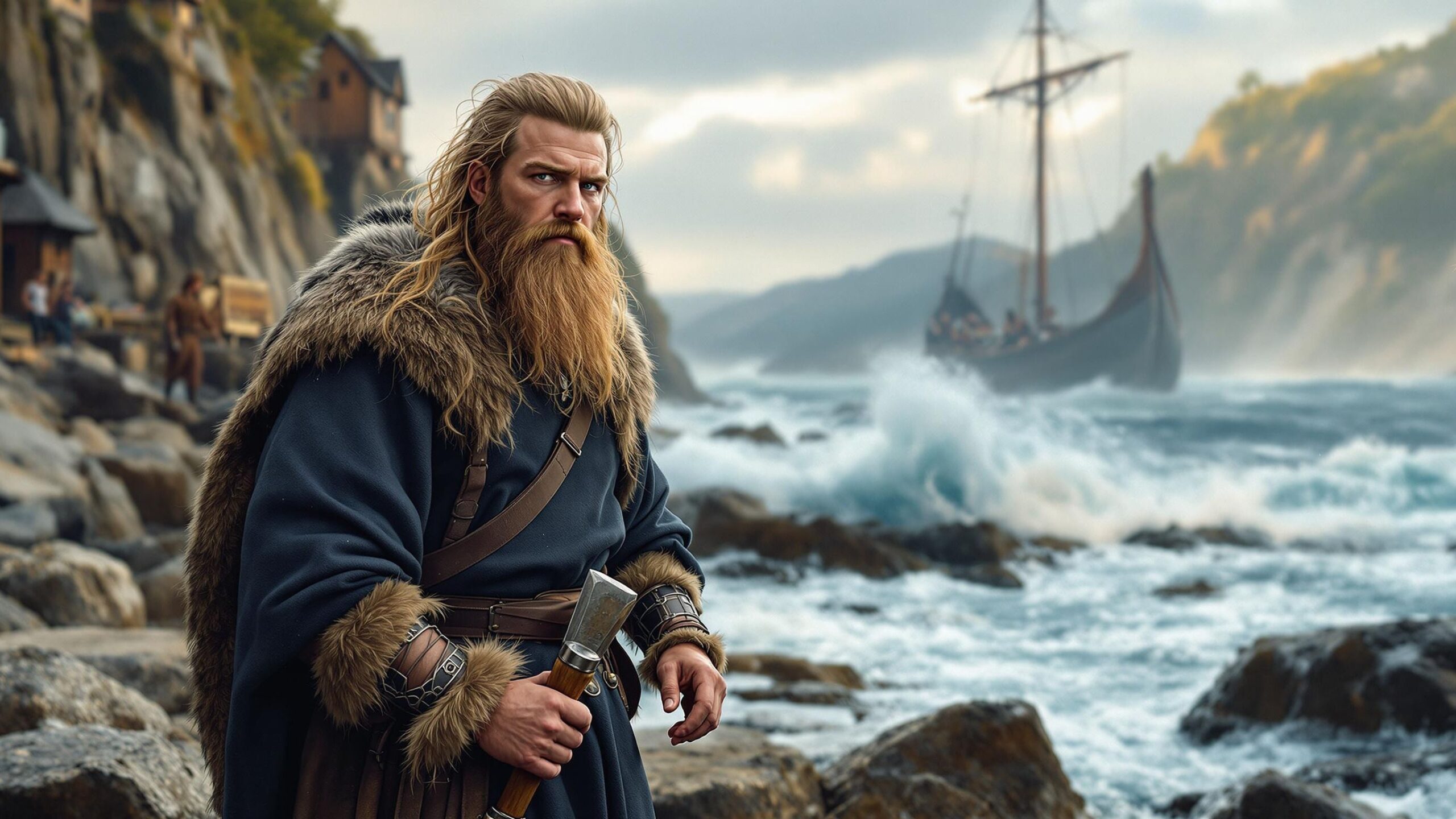Leif Erikson stands as one of the most pivotal figures in Norse history—not because he fought the bloodiest battles or ruled the greatest kingdoms, but because he dared to sail beyond the edge of the known world. The son of Erik the Red and heir to a fierce explorer’s legacy, Leif carried the Viking spirit of adventure into uncharted territories, shifting the course of history not just for Scandinavia, but for the entire globe. With curiosity as sharp as a seax and leadership that bridged war and peace, Leif redefined what it meant to be a Viking. These are the Top 10 ways Leif Erikson forever changed Viking history—through discovery, diplomacy, faith, and fearless exploration.
#10: Discovering Vinland Before Columbus
Leif Erikson’s most famous accomplishment is his voyage to North America—nearly 500 years before Christopher Columbus. Guided by tales from Bjarni Herjólfsson, who had glimpsed new lands to the west, Leif set sail around the year 1000 AD and landed on the shores of what would later be called Vinland. Scholars debate the exact location—most likely Newfoundland—but the impact is undeniable. Leif proved that the Norse were capable of transatlantic navigation, challenging Eurocentric narratives about who “discovered” the New World. His daring expedition placed the Vikings not just in the pages of European history, but in the early chapters of American exploration as well.
#9: Establishing the First European Settlement in North America
Upon reaching Vinland, Leif and his crew didn’t just explore—they built. According to the Saga of the Greenlanders, Leif established a small settlement called Leifsbúðir (“Leif’s booths”). This marked the first attempt by Europeans to colonize the Americas. Though short-lived, the camp included dwellings, food production, and exploration parties. The feat was remarkable: Viking settlers in a new continent, living off the land, and interacting with indigenous peoples. The site of L’Anse aux Meadows in Newfoundland is widely believed to be the remnants of this settlement, offering archaeological evidence that backs the sagas. Leif’s leadership in this endeavor redefined what Vikings could be—not just raiders or traders, but settlers and pioneers.
#8: Spreading Christianity to Greenland
When Leif returned from Norway in the early 11th century, he brought more than tales of distant lands—he brought Christianity. King Olaf Tryggvason had converted him during his time at court and tasked him with spreading the faith. Though his father Erik the Red remained a staunch pagan, Leif succeeded in introducing Christianity to Greenland. Churches were built, and many converted. This was a turning point in Viking history. Leif became a bridge between old Norse beliefs and the Christian world, nudging the Greenland colonies toward religious transformation. His spiritual influence helped lay the foundation for the eventual Christianization of the entire Norse world.
#7: Rebranding the Viking Legacy
Leif Erikson’s deeds helped shift the Viking image from that of bloodthirsty raiders to one of brave explorers. His journey wasn’t about conquest—it was about discovery. In the sagas, he is described as calm, just, and level-headed—a far cry from the berserker stereotype. As more modern scholars revisited Norse history, Leif became a symbol of cultural curiosity and courage. He helped reposition the Viking legacy in global consciousness: not just as destroyers of kingdoms, but as navigators of the unknown. His story balanced the sword with the sail, adding nuance to what it meant to be a Viking.
#6: Inspiring Future Generations of Explorers
Though largely forgotten for centuries outside of Scandinavian tradition, Leif’s exploits saw a revival in the 19th and 20th centuries, inspiring a wave of pride and fascination in Viking heritage. Monuments were raised, stories retold, and explorers from Scandinavia and beyond cited Leif as a spiritual predecessor. The Leif Erikson statue in Reykjavik and others in the U.S. are not just tributes—they are symbols of Viking resilience and ambition. His influence inspired not only national pride but also new generations to re-examine the Norse past with fresh respect for its achievements in navigation and exploration.
#5: Challenging Medieval Geographic Assumptions
Leif Erikson’s westward journey didn’t just extend Viking reach—it disrupted the entire medieval understanding of the world. In an era where much of Europe believed that the known world ended at the western edge of the Atlantic, Leif’s voyage to Vinland was revolutionary. His expedition demonstrated that there were habitable lands far beyond the maps of the time, shattering geographic and cultural boundaries. Though his voyage was largely forgotten in most of Europe during the Middle Ages, the Norse sagas preserved the truth: the world was much larger than anyone had dared to imagine. Leif’s courage in navigating into the unknown not only changed Viking history but challenged the intellectual limits of an entire age.
#4: Elevating the Icelandic Saga Tradition
Leif Erikson’s deeds were immortalized in the Saga of the Greenlanders and the Saga of Erik the Red, two of the most influential sources in Norse literature. These sagas are more than historical records—they are works of art, philosophy, and identity. Leif’s presence in them anchors the narrative of Norse exploration and gives these oral traditions a heroic protagonist that balances strength with humility. His inclusion elevated the sagas beyond tales of raiders and chieftains—they became epics of global scope. Because of Leif, the saga tradition matured into a chronicle of world-changing events, inspiring historians, folklorists, and even novelists centuries later.
#3: Becoming a Symbol of Peaceful Exploration
Unlike many Viking figures known for pillaging, Leif is remembered for peaceful discovery. There are no tales of him burning villages or waging unnecessary wars. His expedition to Vinland, while difficult and fraught with challenges, was fundamentally a mission of exploration and settlement, not conquest. This set him apart in the Norse pantheon. His story resonates today because it presents a different Viking ethos—one rooted in bravery, not brutality. He became a counterpoint to the violent sagas of his ancestors and contemporaries, showing that Norse greatness could also lie in knowledge, resilience, and diplomacy. Leif Erikson helped reframe what it meant to be heroic in the Viking Age.
#2: Cementing Norse Presence in the Atlantic World
Leif’s journey wasn’t an isolated stunt—it was part of a larger Norse push westward across the North Atlantic. With roots in Norway, he settled in Iceland, grew up in Greenland, and sailed to North America. His life encapsulates the entirety of Viking expansion in the west. Through his travels, the Norse established interconnected colonies stretching from Scandinavia to Vinland, forming a unique maritime culture that bridged continents. Leif was the human thread binding these settlements together. His achievements symbolized the Norse capacity not only to conquer seas but to inhabit them, establishing a Viking Atlantic world that predated later European expansion by centuries.
#1: Igniting a Legacy That Survived Empires
Though his voyages were forgotten by many outside the Norse world for centuries, Leif Erikson’s legacy endured where others vanished. He was rediscovered by scholars and celebrated by Scandinavian immigrants in North America in the 19th century, leading to the establishment of Leif Erikson Day in the United States (October 9th). His story outlasted Viking kingdoms, the conversion to Christianity, and even the sagas that carried his name. He became an enduring figure—an emblem of Norse ingenuity and courage who inspired both ancient seafarers and modern dreamers. In surviving the fading of his world and the rewriting of history, Leif proved that true legends don’t die. They navigate time like they navigate oceans—boldly, and with purpose.
Leif Erikson didn’t just sail west—he rewrote the trajectory of Viking history. His voyages expanded the Norse world across an ocean, introduced Christianity to Greenland, and offered a vision of Viking life defined by exploration rather than destruction. He challenged kings, maps, and even gods by sailing into the unknown. Through sagas, settlements, and the echoes of his legacy, Leif became a mythic figure grounded in real courage. In a time when the world seemed smaller, he proved it was vast. And in doing so, he left behind more than a route—he left a legacy of fearless curiosity that reshaped the Norse identity forever.




